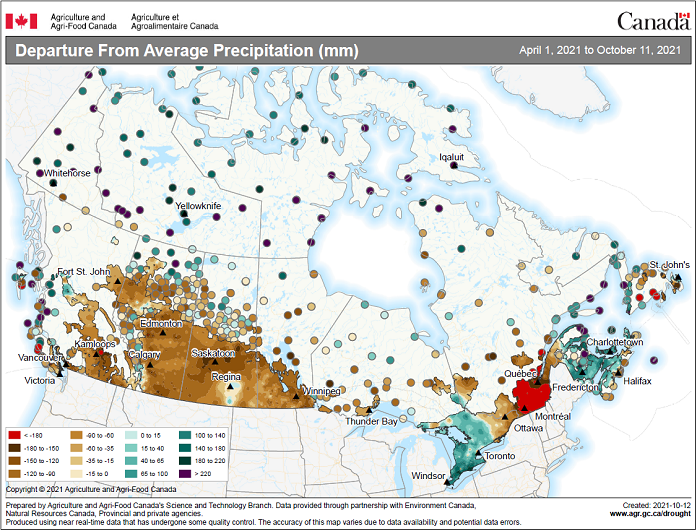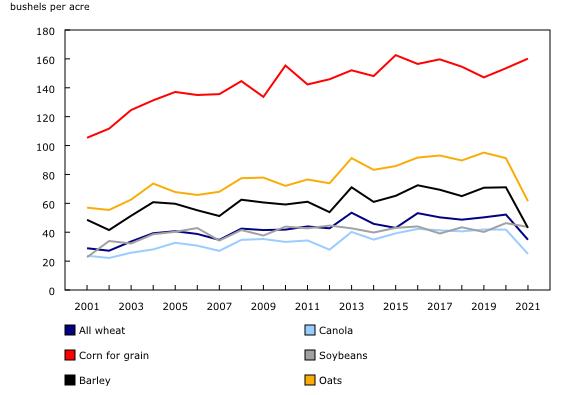Production of principal field crops, November 2021
Archived Content
Information identified as archived is provided for reference, research or recordkeeping purposes. It is not subject to the Government of Canada Web Standards and has not been altered or updated since it was archived. Please "contact us" to request a format other than those available.
Released: 2021-12-03
Canadian farmers produced more corn for grain but less wheat, canola, barley, soybeans and oats in 2021 compared with 2020. Lower yields were driven largely by drought conditions in Western Canada, which resulted in lower production.
Despite favorable spring seeding conditions across most of Canada, extremely hot and dry weather impacted crop development during the growing season in Western Canada. In Eastern Canada, temperatures were near normal throughout much of the growing season, with sufficient moisture in Southern Ontario and the Atlantic provinces, while much of Quebec faced dry conditions.
Warm and dry conditions throughout the fall provided farm operators the opportunity to complete harvest well ahead of the normal timeframe across much of the country.
Because of challenging growing conditions, several major field crops grown predominantly in Western Canada experienced their largest year-over-year yield decrease on record, falling to levels not seen in more than a decade. By contrast, yields for certain crops grown in Eastern Canada, such as corn for grain, rose due to favourable growing conditions.
Lower harvested area and yields push wheat production down
Total wheat production fell 38.5% to 21.7 million tonnes in 2021, because of lower production in the Prairies. Yields (-33.3% to 34.8 bushels per acre) and harvested area (-7.7% to 22.8 million acres) were both down from 2020.
In Saskatchewan, wheat yields decreased by 43.4% to 26.0 bushels per acre, while harvested area decreased by 8.3% to 11.7 million acres, resulting in a 48.1% drop in wheat production to 8.3 million tonnes.
Both yields (-38.4% to 34.4 bushels per acre) and harvested area (-7.5% to 6.7 million acres) decreased in Alberta, resulting in a 42.9% decrease in production to 6.3 million tonnes.
In Manitoba, wheat production was down 28.9% to 3.8 million tonnes. Yields decreased by 21.9% to 47.9 bushels per acre, while harvested area fell 8.9%.
Canola production falls to lowest level since 2007 on poor yields
Canola production decreased by 35.4% nationally to 12.6 million tonnes in 2021, as the drought in Western Canada resulted in the lowest yield since 2007. Yields decreased by 40.2% to 25.0 bushels per acre, offsetting higher harvested area (+8.2% to 22.3 million acres).
In Saskatchewan, canola production was down 45.4% to 6.0 million tonnes, driven by lower yields (-48.5% to 22.0 bushels per acre) offsetting higher harvested area (+6.2% to 12.0 million acres).
Canola yield in Alberta decreased by 31.1% to 27.7 bushels per acre, while harvested area rose 16.3%, resulting in a 19.9% production decrease to 4.2 million tonnes compared with 2020.
In Manitoba, canola production fell 28.2% to 2.3 million tonnes. Harvested area increased by 0.3% to 3.4 million acres, while yields fell 28.3% to 29.7 bushels per acre.
Higher corn for grain production as yields rise
Nationally, the total corn for grain production rose 3.1% to 14.0 million tonnes in 2021. Harvested area fell 1.3% to 3.4 million acres, while yields rose 4.4% to 160.2 bushels per acre.
Ontario farmers reported that harvested area decreased by 0.5% to 2.1 million acres in 2021. The decrease in harvested area was offset by higher yields, which rose 6.9% to a record-high 175.2 bushels per acre, bringing production up 6.4% from 2020 to 9.5 million tonnes.
Corn for grain production in Quebec was up 4.7% from 2020, to 3.4 million tonnes. Harvested area fell 0.6% to 882,300 acres, while yields rose 5.5% to 152.6 bushels per acre.
Farmers report producing fewer soybeans
Soybean production decreased by 1.4% nationally to 6.3 million tonnes in 2021. A 5.6% decrease in yields offset a 4.5% increase in harvested area. Lower national production was largely driven by lower yields in Manitoba, owing to drought conditions throughout the growing season.
Ontario soybean production rose 4.4% to 4.1 million tonnes on higher yields (+1.8% to 51.6 bushels per acre) and higher harvested area (+2.5% to 2.9 million acres).
In Manitoba, soybean production fell 17.1% to 963 800 tonnes, despite a 14.1% increase in harvested area to 1.3 million acres. Yields were down 27.3% to 27.1 bushels per acre as a result of poor growing conditions.
Soybean production in Quebec fell 5.0% from 2020 to 1.1 million tonnes. The decrease in yield (-8.7% to 44.2 bushels per acre) more than offset a 4.1% increase in harvested area.
Barley and oat production fall
Barley production fell 35.3% to 6.9 million tonnes in 2021. While harvested area rose (+6.9% to 7.4 million acres), yields fell (-39.5% to 43.0 bushels per acre) because of dry conditions in Western Canada.
Total oat production decreased by 43.0% nationally to 2.6 million tonnes, on lower harvested areas (-15.4% to 2.7 million acres) and lower yields (-32.6% to 61.5 bushels per acre).
Note to readers
The November 2021 Field Crop Survey about crop production is sent to approximately 27,200 Canadian farms and was conducted from October 8 to November 12, 2021. Farmers were asked to report their estimated seeded and harvested areas, yield and production of grains, oilseeds and special crops. This survey collected data from every province.
This release provides the final production estimates for 2021, which are subject to revision for two years.
Additional data sources
Readers are invited to visit the Crop Condition Assessment Program web application, which is an additional tool to assess growing conditions of field crops during the crop year. Readers can monitor a vegetation index of crop land on a weekly basis.
"Crop Reporting Survey at a Glance," an easy-to-print chart that provides an overview of the survey cycle, is now available.
Contact information
For more information, or to enquire about the concepts, methods or data quality of this release, contact us (toll-free 1-800-263-1136; 514-283-8300; infostats@statcan.gc.ca) or Media Relations (statcan.mediahotline-ligneinfomedias.statcan@statcan.gc.ca).
- Date modified:





